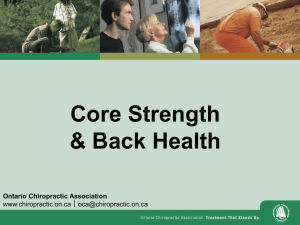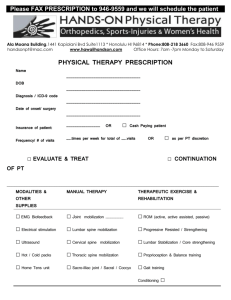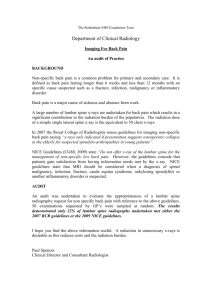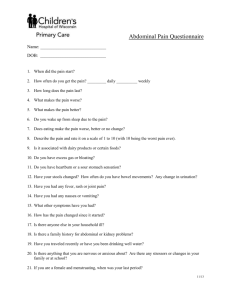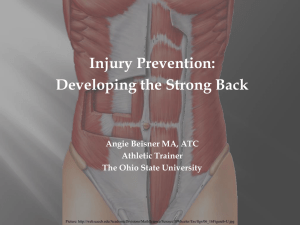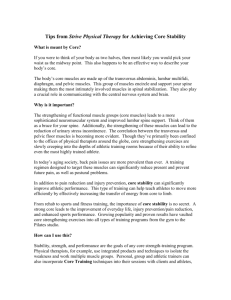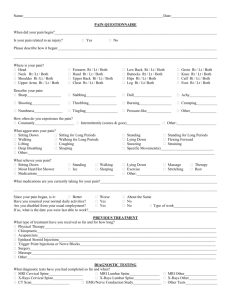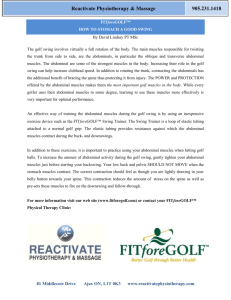The Importance Of Developing A Primary Core Stability Protocol
advertisement
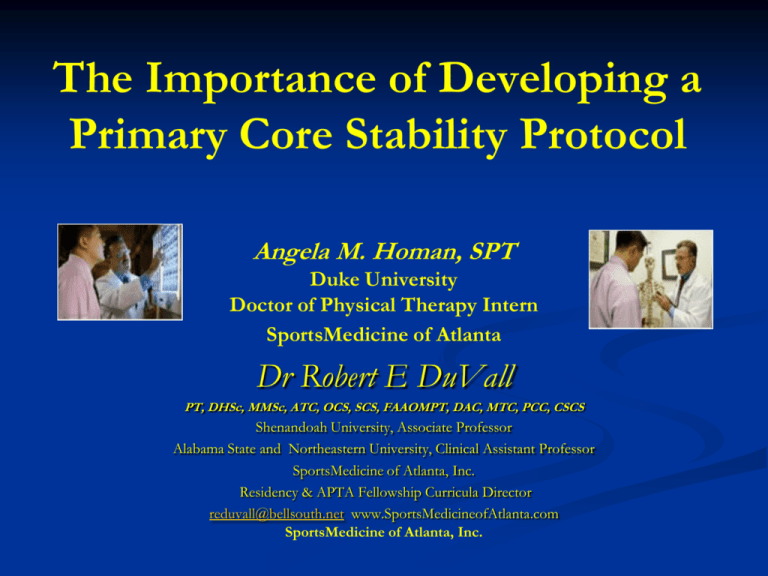
The Importance of Developing a Primary Core Stability Protocol Angela M. Homan, SPT Duke University Doctor of Physical Therapy Intern SportsMedicine of Atlanta Dr Robert E DuVall PT, DHSc, MMSc, ATC, OCS, SCS, FAAOMPT, DAC, MTC, PCC, CSCS Shenandoah University, Associate Professor Alabama State and Northeastern University, Clinical Assistant Professor SportsMedicine of Atlanta, Inc. Residency & APTA Fellowship Curricula Director reduvall@bellsouth.net www.SportsMedicineofAtlanta.com SportsMedicine of Atlanta, Inc. NMR Research Shown Beneficial to Reduce Pain and Disability "In America alone, the treatment cost of back pain is estimated to be $86 billion per year or 9% of the country's total health expenditure. The search for new ways to manage this old problem is critical in order to improve the health and quality of life of individuals who struggle with this condition.“ According to researchers not only do patients feel less pain, but patients performing these types of exercises are able to be more physically active and experience positive effects over a longer period of time than those who receive other treatments. Macedo, Luciana G. Maher, Christopher G. Latimer, Jane. McAuley, James H. Motor Control Exercise for Persistent, Nonspecific Low Back Pain: A Systematic Review. PTJ 2009;89(1).9-95. Primary Core Transverse Abdominis (TrA) Multifidus Transverse Abdominis Anatomy Origin: inner surface of cartilages of lower 6 ribs, interdigitation with diaphragm, thoracolumbar fascia, anterior ¾ of internal lip of iliac crest, and lateral 1/3 of inguinal ligament Insertion: linea alba (broad aponeurosis), pubic crest, and pecten pubis Nerve Innervation: T7-T12, L1 (iliohypogastric and ilioinguinal) Kendall et al. Actions of TrA Flattens abdominal wall and compress the abdominal viscera Decrease infrasternal angle of ribs in expiration (upper portion of TrA) No Action in lateral trunk flexion, except to compress the viscera and to stabilize linea alba (= better action of anterolateral trunk muscles) Kendall et. al. Weakness in TrA (observations) Standing position: Permits bulging of anterior abdominal wall (= increases lordosis) Supine position: during flexion a lateral bulge tends to occur Prone position: hyperextension of trunk with lateral bulge tends to occur Kendall et al. Multifidus Anatomy Origin: Sacral region: posterior surface of sacrum, medial surface of posterior iliac spine & posterosacroiliac ligaments. Lumbar, thoracic, & cervical regions: transverse processes of L5-C4 Insertion: Spanning two to four vertebrae, inserting onto spinous process of one of vertebra above from last lumbar to axis (second cervical vertebra Nerve Innervation: Spinal Kendall et al. Actions of Multifidis Extends vertebral column and rotation toward opposite side. Kendall et al. Functions of TrA & Deep Multifidus Deep Multifidus and TrA provide intersegmental spinal stability Deep fibers of Multifidus control intervertebral motion Superficial fibers of Multifidus control spine orientation Moseley GL, Hodges PW, Gandevia SC. Deep and superficial fibers of the lumbar multifidus muscle are differentially active during voluntary arm movements. Spine. 2002;27:E29–E36. TrA Muscle Activation Patterns TrA may be controlled independently of the motor command for limb movement in contrast to the other abdominal muscles. Feedforward TrA activation pattern with Lower extremity movement Hodges P, Richardson C. Contraction of the abdominal muscles associated with movement of the lower limb. Physical Therapy. 1997;77:132-144. Feedforward activation TrA activation pattern with upper extremity movement Hodges PW, Richardson CA. Transversus abdominis and the superficial abdominal muscles are controlled independently in a postural task. Neuroscience Letters. 1999;265:91-94. Hodges P, Richardson C. Feedforward contraction of transversus abdominis is not influencedby the direction of arm movement. Experimental Brain Research. 1997;114:362-370. Preparatory trunk movement precedes upper extremity movement Hodges P, Cresswell AG, Daggfeldt K, Thorstensson A. Preparatory trunk motionaccompanies rapid upper limb movement. Experimental Brain Research. 1999;124:69-79 Hodges P, Cresswell AG, Daggfeldt K, Thorstensson A. Three dimensional preparatory trunk motion precedes asymmetrical upper limb movement. Gait and Posture. 2000;11:92-101. . Core Dysfunction: Anatomy Transverse Abdominis: Isometric Knee extension/flexion tasks identified subjects with LBP had smaller increase in TrA thickness and less EMG activity Ferreira PH, Ferreira, Hodges PW. Changes in recruitment of the abdominal muscles in people with low back pain ultrasound measurement of muscle activity. Spine. 2004;29:2560-2566. Core Dysfunction: Anatomy Multifidus: Atrophy of multifidus has been used as a rationale for spine stabilizing exercises. Barker et al, found selective ipsilateral atrophy of multifidus in patients with unilateral LBP (low back pain) MRI analysis of the CSA of Multifidus At level of pain: 21.7 % decrease Above level of pain: 15.8% decrease Below level of pain: 16.8% decrease Decreased CSA at level of pain was positively correlating with duration of pain. Barker KL, Shamley DR, Jackson D. Changes in the cross-sectional area of multifidus and psoas in patients with unilateral back pain. The relationship to pain and disability. Spine. 2004;29:E515-E519. Core Dysfunction: Activation Patterns Subjects with chronic LBP do not pre-activate TrA prior to rapid upper and lower limb tasks. Barr KP, Griggs M, Cadby T: Lumbar stabilization: Core concepts and current literature, part 1. Am J Phys Med Rehabil. 2005;84:473-480. Hodges P, Richardson C. Inefficient muscular stabilisation of the lumbar spine associated with low back pain: a motor control evaluation of transversus abdominus. Spine. 1996;21:2640-2650. Onset of internal obliques, multifidus, & gluteus maximus was delayed on the symptomatic side (>20ms)= no feed-forward activation in subjects with sacroiliac joint pain Hungerford B, Gilleard W, Hodges P, Evidence of altered lumbopelvic muscle recruitment in the presence of sacroiliac joint pain. Spine. 2003;28:1593-1600. TrA Muscle Activation Three different techniques used in clinical practice: Drawing-in Maneuver Abdominal Bracing Posterior Pelvic Tilt Drawing-in Maneuver is more selective in coactivating the TrA and multifidus than the other 2 techniques. Hodges, PW, Richardson, GA, and Jull, G: Evaluation of the relationship between laboratory and clinical tests of transversus abdominis function. Physiother Re Internat 1(1):30, 1996. Richardson, C, Jull, G, et al: Techniques for activae lumbar stabilisation for spinal protection: A pilot study. Austral J Physiother 38:105, 1992. Drawing-In Manuever Recommended for stabilization training Functions to ↑ intra-abdominal pressure by inwardly displacing the abdominal wall. Increases CSA (cross sectional area) of TrA on MRI (TrA contracts bilaterally to form a musculofascial band that appears to tighten like a corset and most likely improves stability of lumbopelvic region. Hides J, Wilson S, Stanton W, et al. An MRI investigation into the function of the transversus abdominis muscle during “drawing-In” of the abdominal wall. Spine. 2006;31:E175-E178 Drawling-in Maneuver: Patient starts in hook-lying position and assumes a neutral spine position & attempts to maintain it while drawing in and hollowing the abdominal muscles. Kendal, F, McCreary, E, and Provance, PG: Muscles: Testing and Function, ed 4. Williams & Wilkins, Baltimore, 1993. Subtle posterior pelvic tilt & flattening of lumbar spine. No flaring of lower ribs, bulging out of abdominal wall or ↑ pressure through feet. Instructions: draw the “belly button” up and in toward the spine while exhaling Feedback Techniques If patient is having difficulty activating the Transverse Abdominis, the following has been used to assist with learning: Pressure transducer for clinical testing and visual feedback (Pressure Bio-Feedback Chatanooga Pacific) Biofeedback with surface electrodes Hagins, M, et al: Effects of practice on the ability to perform lumbar stabilization exercises. J Orthop Sports Phys Ther 29(9):546, 1999. Jull, GA, and Richardson, CA: Rehabilitation of Active Stabilization of the Lumbar Spine. In Twomy, LT and Taylor (eds): Physical Therapy of the Lumbar Spine, ed 2. Churchill Livingstone, New Yourk, 1994. Richardson, C, Jull, G, et al: Techniques for active lumbar stabilization for spinal protection: A pilot study. Austral JPhysiother 38:105, 1992. Richardson C, and Jull, G: An historical perspective on the development of clinical techniques to evaluate and treat the active stabilizing system of the lumbar spine. Austral J Physiother Monograph 1:5, 1995. Visual Feedback- hook-lying Place small inflatable bladder with pressure sensor (similar to BP cuff) under lumbar spine and inflate it to 40-mm Hg. Correct Activation: 10-mm Hg increase in pressure Large increase occurs if activating rectus abdominis and/or increased lumbar flexion (posterior pelvic tilt). No change in pressure = no activation of TrA Visual Feedback- hook-lying Biofeedback with surface electrodes Electrodes placed over rectus abdominis & external obliques (near attachment on the 8th rib). Correct activation: minimal to No activation of these muscles Can be used in conjunction with inflatable cuff. Abdominal Bracing Occurs by setting the abdominals and actively flaring out laterally around the waist Technique has been taught years It has been shown to activate the oblique abdominal muscles Richardson, C, Jull, G, et al: Techniques for active lumbar stabilization for spinal protection: A pilot study. Austral JPhysiother 38:105,1992. Posterior Pelvic Tilt Activates Rectus Abdominis: it is NOT a core spinal stabilization muscle Only useful for teaching awareness of the movement of the pelvis and lumbar spine. Activated when patient explores lumbar ROM with pelvic tilts to find neutral spine position. Richardson, C, Jull, G, et al: Techniques for active lumbar stabilization for spinal protection: A pilot study. Austral JPhysiother 38:105,1992 Lower Abdominal Progression Levels developed by Shirley A. Sahrmann Purposes: To improve the performance of abdominal muscles (external obliques, rectus abdominis, transverse abdominis) To learn to prevent lumbar spine motions associated with leg motion Starting Position -Sahrmann Supine with hips and knees flexed and feet on the floor. Contract abdominal muscles by flattening the abdomen and reducing the arch in the lumbar spine. Patient is instructed to place fingers on abdominal muscles and “pull the navel in toward the spine.” Level 0.3 (E1)-Sahrmann Lift one foot with alternate foot on floor Method: Flex one hip while keeping knee flexed. Return the LE to starting position and repeat with opposite LE. Level 0.4 (E2)- Sahrmann Hold one knee to chest & lift the alternate foot Method: Flex one hip and use hands to hold knee to chest. While maintaining contraction of abdominal muscles, flex the other hip. Hold for a count of 3 and return the LE to starting position. Perform with opposite extremity. Repeat 5-6 times Level 0.5- Sahrmann LIGHTLY hold one knee toward the chest and lift the alternate foot Methods: Flex one hip and use one hand to hold knee to chest, but hold it less firmly than level E2 (0.4). While maintaining contraction of abdominal muscles, flex other hip. Hold for a count of 3 and return the LE to starting position Perform with the opposite extremity. Repeat 5-6 times Level 1A- Sahrmann Flex the hip to > 90˚and lift the alternate foot Methods: Contract the abdominal muscles; flex one hip to > 90 degrees by lifting the foot from the table. Contract the abdominal muscles and flex the other hip by lifting the foot off the table. Maintain the contraction of abdominal muscles and lower the legs, one at a time, to starting position. Repeat by starting the sequence with opposite leg. Level 1B- Sahrmann Flex the hip to 90˚ and lift the other foot. Methods: Contract abdominal muscles and flex one hip to 90 degrees. Contract abdominal muscles and lift other leg to same position. Maintain contraction of abdominal muscles, lower the legs one at a time to starting position. Repeat by starting the sequence with the opposite LE. Repeat, alternating legs, correctly 10 times to progress to Level 2. Level 2-Sahrmann Flex one hip to 90˚ and lift & slide the other foot to extend the hip and knee. Methods: Contract abdominal muscles and flex hip to 90 degrees, lifting foot off the table. Maintain contraction of abdominal muscles; lift other leg up to same position. Maintain one leg at 90 degrees, place other heel on table and slowly slide heel along table until hip and knee are extended. Return leg to starting position by sliding hell along table. Repeat extension motion with other LE and return it to starting position. Repeat, alternating legs, correctly 10 times to progress to Level 3. Level 3-Sahrmann Flex one hip to 90 degrees, and lift the foot and extend the leg without touching the support surface. Methods: Flex hip to 90 degrees, lifting foot from the table. Maintain contraction of abdominal muscles and lift other leg up to same position. Maintain one hip at 90 degrees, extend the other hip and knee while holding the foot off the table until hip and knee are resting in an extended position on the table. Return leg to the hip and knee flexed position. Maintain contraction of abdominal muscles, extend and lower the other leg and return it to the 90 degree position. Repeat, alternating legs, correctly 10 times to progress to Level 4. Level 4-Sahrmann Slide both feet along the supporting surface into extension and return to flexion Methods: Begin in supine position with both legs in extension. Contract abdominal muscles and slide heels along table, flexing both hips and knees while bringing them toward the chest. Once hips and knees are flexed, pause and reinforce abdominal contraction. Slide both legs back into extension. Repeat correctly 10 times to progress to Level 5 Level 5-Sahrmann Lift both feet off the supporting surface, flex the hips to 90 degrees, extend the knees, and lower both extremities to supporting surface. Methods: Begin with LE extended position. Contract abdominal muscles while simultaneously flex hips and knees, lifting both feet off the table to bring the hips to 90 degrees. Reinforce the contraction of abdominal muscles, extend the knees and lower LEs to table. Primary Core Protocols Transverse Abdominis (Levels I-V) Multifidus (Levels I-III) http://lowerabexercises.blogspot.com/ The TrA Level Progression These proposed levels were designed from the research and are clinically applied to strengthen the Transverse Abdominis in isolation. Purpose: To have a common terminology among practicing clinicians in the same physical therapy setting. To improve the performance of TrA muscle. To prevent lumbar spine motion (neutral spine) during functional activity. Starting Position: TrA Level I Method: Supine with hips & knees flexed and feet on the floor. Patient is instructed keep a Neutral lumbar spine using the „Drawing-in Maneuver‟ and place two fingers on transverse abdominus and one hand on superficial abdominal muscles. Next, patient is asked to “pull the navel in toward the spine” without tightening superficial abdominal muscles and only the TrA. TrA Level I Level I will be the starting position for all levels I-V. TrA Level II Lift one foot to 90 degrees with alternate foot on table Method: Contract TrA and flex one hip to 90 degrees while keeping knee flexed. Return the LE to starting position and repeat with opposite LE. TrA Level III Flex the hip to 90˚ and lift the other foot. Methods: Contract TrA and flex one hip to 90 degrees. Lift other leg to same position. While maintaining contraction of TrA, lower the legs one at a time to starting position. Repeat by starting the sequence with the opposite LE. Repeat, alternating legs, correctly 10 times to progress to Level 4. TrA Level III TrA Level IV Flex one hip to 90 degrees, and lift the other foot. Extend the one leg without touching the support surface. Methods: Flex hip to 90 degrees, lifting foot from the table. Maintain contraction of TrA and lift other leg up to same position. Maintain one hip at 90 degrees, extend the other hip and knee while holding the foot off the table. Return leg to the hip and knee flexed position. Maintain contraction of abdominal muscles, extend other leg and return it to the 90 degree position. Repeat, alternating legs, correctly 10 times to progress to Level 5. TrA Level IV TrA Level V Flex the hips to 90 degrees and extend the knees without touching the support surface. Methods: Flex hip to 90 degrees, lifting foot from the table. Maintain contraction of TrA and lift other leg up to same position. Extend both hips and knees while holding the feet off the table. Return legs to the hip and knee flexed position. Repeat correctly 10 times. TrA Level V Multifidus Level Progression (I-III) These proposed levels were designed from the research and are clinically applied to strengthen the Multifidus in isolation. Purpose: To have a common terminology among practicing clinicians in the same physical therapy setting. To improve the performance of Multifidus muscle. To prevent lumbar spine motion (neutral spine) during functional activity. Multifidus Level Ia Start position: Quadriped Neutral lumbar spine Have patient lift one lower extremity (LE) ( knee) ~ 1 inch from table Hold position ~ 5 seconds Alternate with the other LE. Multifidus Level Ib Start position: Quadriped Neutral lumbar spine Have patient lift one LE (knee) and the contralateral upper extremity (UE) (hand) ~ 1 inch from table Hold ~ 5 seconds Alternate with the other LE and contralateral UE Multifidus Level II Starting position: Prone Maintain neutral lumbar spine (i.e. placement of pillow) Lift one UE and contralateral LE from the table Alternate with other UE and contralateral LE. Multifidus Level III Starting position: standing on stool facing wall Extend one UE and contralateral LE Alternate with other UE and contralateral LE Clinical Biomechanics: Intervention Skill Sets NMR (97112) Longus Colli Isolation Text References Kendall, FP et al. Muscles Testing and Function with Posture and Pain. Fifth edition, 2005. Sahrmann, SA. Diagnosis and the Treatment of Movement Impairment Syndromes. 2002. Kisner, C & Colby LA. Therapeutic Exercise: Foundations and Techniques. Fourth edition, 2002.
